To tie Andrew Herd's Bat Fly, you will need a packet of Polo mints, a pair of shears and a full-bore rifle.
This fly is named after Rile. E. Smales, a lurcher of ill-repute. The worst thing Riley has ever done is to roll on a long dead deer, followed by a nearly as long dead sheep, before having diarrhoea in the back of the pickup on the way home - his final act being to fall over in it. Left to his own devices, he would be a stranger to shampoo and theories abound about him being a believer in allowing a build up of natural oils. Despite his abject failure to meet even the minimum standards of canine hygiene, Riley is a confident animal who knows that everyone loves him; and the worse he smells, the closer he likes to be to his friends. But he does have the most wonderful coat.
To tie the Bat Fly, you will need a packet of Polo mints, a pair of shears and a full-bore rifle
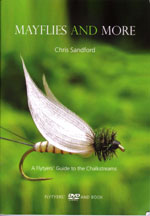
Text and photographs courtesy of Andrew Herd. Taken from The Flies That Catch Fish, by Chris Sandford. Published by the Medlar Press.
We have reviewed this excellent book and the accompanying DVD here.
To tie the Bat Fly, you will need a packet of Polo mints, a pair of shears and a full-bore rifle. The shears are used to trim the fur off Riley, but any grey/black mix will probably do the job, besides being less of a health hazard and very probably easier to dub. I am tempted to say that you ought to comb out the blue underfur using a special ceramic tool, but I fear it makes no difference. It is useful if you have a small boy like Master Hicks on hand to capture the dog and to prevent any last minute escapes.
The Polos are necessary to catch my hunter, Druid, a natural lout who can be tough to catch up at the best of times and impossible when the grass is good, but his weakness is that he would mortgage his granny for a mint. Being a bay horse, he has a black tail, a single strand of which is used to rib the fly. If you can't face the trek up to Durham, any bay will do, and black silk should work at a pinch should disaster strike and you run out of mints.
For those of you who are wondering, the rifle is used to shoot the deer, as they aren't too keen on the idea of standing around while you sneak up on them brandishing a pair of scissors. You are looking for a roe buck in full summer coat, so you may have to wait until June to get a good one, but substituting elk hair will do at a pinch. Just don't use any more than that.
Method:
leave the tying until five minutes after you are due to leave and then slap it all on whichever way works best for you. Throw the result on top of the dash so that the varnish can dry in the draft from the blower. Pick up the flies from where they have fallen in the floor well and drop them (do not under any circumstances fix them) in your fly box, so that they will blow out and get lost in the grass with the first gust of wind. Careful experiment has shown that the fish do not seem to mind the fly being treated this way and doing things in a rush may actually improve the pattern. If you tie 6, you will probably end up with one left by the time you get to the water, which will rise 3 fish on the first three casts and then break off on the fourth.
The pattern works best in early season when there are black sedges on the water and the hawthorn flies are out. The major problem with it is that it is sometimes better at catching bats than trout and I recall an evening on the Visocica where not only did the fly fool several bats, it fooled the same bat several times - the only time in 40 years of fly fishing that I can recall this happening. I was working down a tunnel of trees and the bat picked the fly off the water, dropped it, did a stall turn and picked it up again, dropped it, did a low level circuit and came back a third time. The pair of us might have been there yet had not a trout finally taken the fly. Relying on bats to make your presentation for you is chancing it, in my opinion.
Fishing directions:
start with it dry and let it get wet. If sedges are about, it will start working sooner or later.
Dressing:
(modified so that you don't need a lurcher or a bay horse at hand)
PS. My wife Barbara tells me the shears are for poultry, but what does she know?
I'm saying nothing - hens don't have fur.
- Log in to post comments







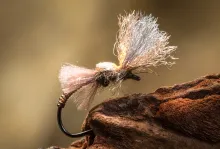
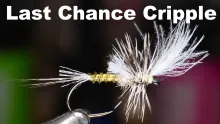
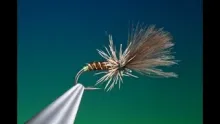
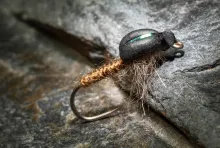


My wife tells me tha
My wife tells me that she is starting a fan club for your lurcher. And she is now looking at our tri colored Llewellyn setter Lindy with renewed interest.
We had an Australian Shepard
We had an Australian Shepard of the same habit named Pumpkin. Like most Aussies she had tri-color fur with the predominant color an orangish tan, so of course she was named Pumpkin. While she would roll in anything smelly, her preference was for bear or moose dung. When we all got out of the car at our fishing spot on the Kennebec near the outlet from Moosehead Lake, Pumpkin lifted her nose, gave a shudder of delight and suddenly dashed out of sight. This was out of character since she always stayed close to us. Worried she might have found a bear, we went looking for her. We found her alright, rolling delightedly in an enormous pile of moose droppings. Before we could drive home later, we had to spend well over an hour washing her with in a lake. Thirty years later, I’m still tying nymphs with Pumpkin Dub.